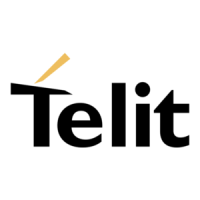LE910C1 Hardware User Guide
1VV0301298 Rev. 1.08 - 2017-11-14
Reproduction forbidden without written authorization by Telit Communications S.p.A. - All Rights Reserved
Telit Confidential Information, provided under NDA Page
64 of 119
7. Antenna(s)
Antenna connection and board layout design are the most important parts in the full product
design, and they have a strong influence on the product’s overall performance. Read carefully and
follow the requirements and guidelines for a good and proper design.
7.1. GSM/WCDMA/LTE Antenna Requirements
The antenna for the LE910C1 device must meet the following requirements:
Table 18: GSM / WCDMA/ LTE Antenna Requirements
Frequency range The customer must use the most suitable antenna band width for
covering the frequency bands provided by the network operator and
also supported by the car OEM while using the Telit module.
The bands supported by each variant of the LE910C1 module family
are provided in Section 2.6.1, RF Bands per Regional Variant.
Gain Gain < 3 dBi
Impedance 50 Ohm
Input power > 33 dBm(2 W) peak power in GSM
> 24 dBm average power in WCDMA & LTE
VSWR absolute max <= 10:1
VSWR recommended <= 2:1
Since there is no antenna connector on the LE910C1 module, the antenna must be connected to
the LE910C1 antenna pad (K1) by a transmission line implemented on the PCB.
If the antenna is not directly connected to the antenna pad of the LE910C1, a PCB line is required
to connect to it or to its connector.
This transmission line must meet the following requirements:
Table 19: Antenna Line on PCB Requirements
Characteristic impedance 50 Ohm
Max attenuation 0.3 dB
Avoid coupling with other signals.
Cold End (Ground Plane) of the antenna must be equipotential to the LE910C1 ground pads.

